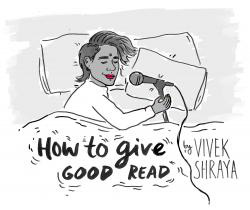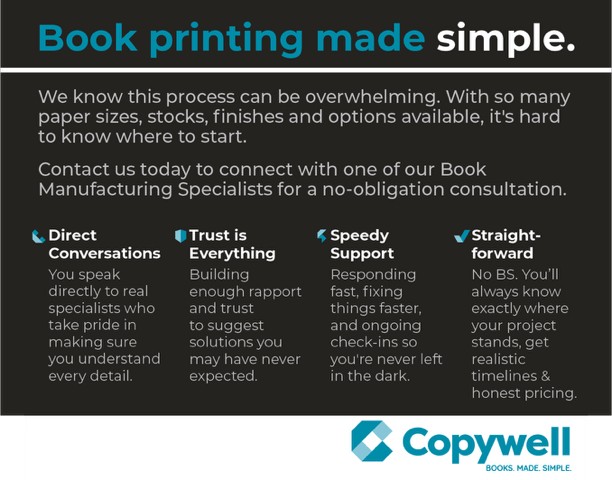How to Give Good Read
By Vivek Shraya & Submitted by kateburgess
In a month, I will be hitting the road to tour my new book of poetry, even this page is white. In addition to trying to manage the general anxieties that arise when putting art into the world, I have begun rehearsing.
Rehearsing what? Good question! While I respect that many authors are opposed to book readings, feeling that writers should not also have to be performers, I look forward to book readings as a way to make a live connection with potential readers. I like seeing what the words can sound and feel like off the page, flexing them into new meanings. Also, as someone who comes from a self-publishing background, I have often been forced to think about promotion from a business perspective, and the truth is that a good reading—one that moves, inspires or entertains the audience—often translates to sales.
Here is what I have learned about how to give good read:
Start In The Writing Phase
Before I toured my first book, God Loves Hair, no one told me that there would be a good chance that I would have to read the stories out loud. To be honest, I had no idea what touring a book involved. Thankfully, while I was writing, I worked with the text orally, reading sections aloud to listen to whether or not phrases flowed smoothly. This was an intuitive strategy, and one I recommend to all writers, as I have found that if a sentence flows well orally, it will read well on the page. And, when the time comes to give a book reading, you will have the confidence of knowing your words will sound great live.
Prepare & Practice
As writers, we aren’t entitled to an audience. When someone comes to a reading or book event, they are taking time out of their lives to support our work. This is a gift and I believe one of the ways to honour this gift is to invest time in preparing in advance for an event. For me, preparing involves considering who the audience will be, what the purpose of the event is, as well as any specific themes, and then selecting sections of my writing that I feel are a good fit. Many of my writer peers prefer to choose what to read once they get to the venue, and I think this is a sound strategy, but I also think it’s worth identifying a few potential reading options in advance so you aren’t stressing or guessing too much at the event.
One way to determine what to read is to practice, and by practice I mean reading the text out loud to yourself. In doing so, pay attention to what passages excite you, that you feel proud of as these feelings (or the opposite, if you choose a selection you are uncertain about or tired of reading) will come across to the audience. As someone who often writes about the personal, I like to choose passages that scare me a little, because I am drawn to the challenge and potency that vulnerability has to offer but of course, you should consider what makes you feel comfortable.
Makes notes in your margins of words you trip on or want to emphasize so you can remember to slow down. Play around with the volume of your voice—maybe there are lines you want to whisper. Try practicing in front of a mirror, as cheesy or cliche as that sounds. This is something I have done since I first started public speaking as a teenager, and I have found it very helpful as a way to give myself a semblance of an audience. Some of my peers even videotape themselves reading. This allows you to notice if you have unconscious habits that are less endearing and more distracting, like fidgeting with your sleeve or hair (I am very guilty of the latter). If you have time, I also recommend doing a test reading for a friend or two. Buy them dinner and ask them for feedback—what pieces stood out to them or what pieces bored them.
Time Yourself
I can’t tell you how many times an organizer has informed all the writers on a panel or event I have been part of that we have five minutes each, and one of the writers has read for two or three times as long. This is disrespectful to the organizer(s), the audience, because some of the people there might not have come to see you, and also to the other writers on the bill. The message that going over your time limit sends (and I am not talking about just one or two minutes over) is one of selfishness or superiority.
This is another reason why practicing in advance is useful and important. That two-page chapter that you thought would take only five minutes to read might actually take ten. I always aim to read for slightly less than the given time limit because I have found that the principle of “leaving an audience wanting more” is worth abiding by. And if no time limit is given to you, a reading should never be more than fifteen minutes. In my experience, after this stretch of time, attention seems to wane. For this reason, I tend to keep my readings to twelve minutes.
Befriend The Mic
In the music world, singers are often told to “eat the mic,” which basically means sing right into the microphone, almost like you are making out with it. This is because singers are often competing with a multitude of different sounds. Book events tend to be less sonically competitive, but because writers are often shy and introverted, we tend to fear the microphone, and therefore stand far from it, as though it might eat us if we step too close to it.
Your CanLit News
Subscribe to Open Book’s newsletter to get local book events, literary content, writing tips, and more in your inbox
I am here to tell you that the mic is your friend. Walk right up to it, and speak into it. You don’t have to yell. Like a good friend, you can rely on it to help amplify your voice. But first, make sure the head of the mic is pointing directly at your mouth—not your chin, not your neck. You shouldn’t have to hunch over to speak into the mic, and your mouth shouldn’t be further than two inches away from it. Don’t hesitate to adjust the mic or the mic stand, or to ask for help from the organizer with this. People want to hear the beauty of your words. It’s worth spending thirty seconds to get the mic properly positioned for you, so the audience can hear you without having to strain.
Use What You’ve Got
I have a short attention span, so I am always trying to think of ways to hold the audience’s attention. At my readings, I often sing and project illustrations from my books. You don’t have to do magic tricks (unless you want to!), but if you have other talents or hobbies, feel free to integrate them into your readings. For example, you could project photos from your childhood album, or even a singular image that you feel summarizes or connects to what you are reading. Whatever you include, make sure it relates to and enhances the writing, as opposed to detracting from it.
The views expressed by Open Book columnists are those held by the authors and do not necessarily reflect the views of Open Book.
Vivek Shraya is a Toronto-based artist whose body of work includes several albums, films, and books. Her first novel, She of the Mountains, was named one of The Globe and Mail’s Best Books of 2014. Her debut collection of poetry, even this page is white, was released this spring, and her first children’s picture book, The Boy & the Bindi, was published this fall. Vivek has read and performed internationally at shows, festivals and post-secondary institutions, including sharing the stage with Tegan & Sara. She is one half of the music duo Too Attached.
Vivek is a 2016 Pride Toronto Grand Marshal, a three-time Lambda Literary Award finalist, a 2015 Toronto Arts Foundation Emerging Artist Award finalist, and a 2015 recipient of the Writers’ Trust of Canada’s Dayne Ogilvie Prize Honour of Distinction.




